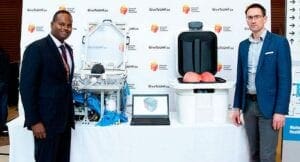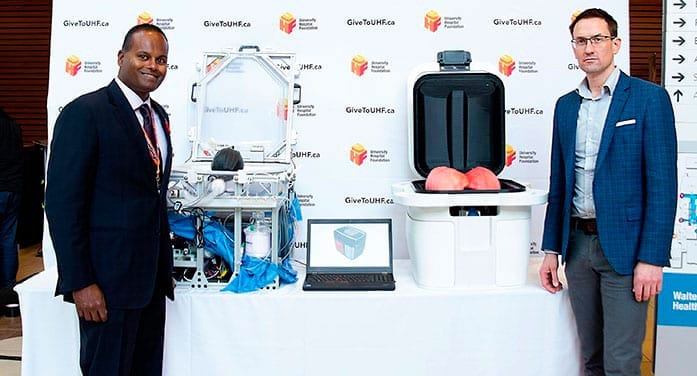University of Alberta spinoff company Tevosol has merged with the U.S.-based medical technology company Bridge to Life, bringing its game-changing organ transplant devices a step closer to approval, manufacture and global distribution.

While Tevosol will remain based in Edmonton, Bridge to Life has committed US$10 million to a multi-centre clinical trial and commercial development of Tevosol’s Ex-Vivo Organ Support System (EVOSS), which keeps donated lungs healthy while they are transported for transplant, and US$10 million more for a second device under development that will preserve donor hearts, said Jayan Nagendran, associate professor of cardiac surgery and co-founder of Tevosol.
“Securing funding for our commercial efforts will make a huge difference for individuals who are waiting for transplantation,” said Darren Freed, professor of cardiac surgery and Tevosol founder.
“We are going to be able to offer them better quality organs in a more timely fashion, and that should translate into better outcomes,” said Freed, who is now chief scientific officer for Bridge to Life.
FROM THE ARCHIVES: ‘Lungs in a box’ could ease organ shortage
About 4,000 lung transplants are performed each year, but fewer than one in four donated organs are used because they’re not in good enough condition. The EVOSS technology will change that dramatically, noted Nagendran, who is surgical director of lung transplantation at the University of Alberta Hospital, research director of cardiac surgery at the Mazankowski Alberta Heart Institute, and now chief medical officer for Bridge to Life.
“We would like to increase the utilization rate to 50 per cent because we know our device can take organs that don’t look great and actually convert them to usable organs, so we can double the number of transplants happening right away,” he said.
“We think we could be doing 8,000 transplants per year with our devices within two to three years.”
The negative-pressure lung preservation device mimics the way lungs work in the human body and improves on previously available forced-air ventilation systems. Invented by Freed in 2016, it has since been used to successfully complete 12 transplants in patients, according to recently reported results in Nature Communications. The American trial will involve 180 patients at six U.S. hospitals, with a goal of obtaining U.S. Food and Drug Administration approval.
“We’re so close to the clinic and so close to the market, but these last steps can get expensive when you have to manufacture machines and seek FDA approval,” said Ron Mills, CEO of Tevosol. “This partnership gives us global reach, an established sales organization and a successful business that’s a foundation for everything.”
Once the lung devices are approved, the team hopes to supply them to the 150 major transplant centres and organ procurement organizations across North America, along with single-use disposable parts, much like printers that require ink cartridges.
The heart preservation technology is about a year and a half behind the lung technology in its development, Nagendran said. He hopes first-in-human trials for the heart device will take place in 2022.
Nagendran and Freed met when they were both surgical residents at the U of A. Following graduate and postgraduate studies that took them to Stanford (Nagendran), Cambridge (Freed) and elsewhere, they were attracted back by the U of A’s renowned transplant program.
“The University of Alberta Hospital is one of the largest multi-organ transplant programs in the world, not just in Canada,” said Freed. “As a consequence of being a very large-volume centre, there’s tremendous expertise that’s been established and there’s a rich history of research.”
The strong support for clinical research allows surgeon-scientists to translate their work into real-world, practical solutions that benefit patients, Freed said.
“There are multiple reasons why innovation occurs, but the common thread is essentially insatiable curiosity fuelled by a recognition that there’s got to be a better way,” he said.
“The concept of leaving donated organs in a bucket of ice and racing around the country or the continent (to transplant them) had not evolved much – that’s how we treated these precious gifts of life,” said Nagendran.
“As surgeons, we truly understand both the organ and patient needs, and we were able to quickly refine our designs to come up with something that is truly revolutionary, bringing medical technology to better serve these organs,” he said.
Both Nagendran and Freed credited their rapid success to the support received from the University of Alberta, Alberta Health Services and the University Hospital Foundation, as well as the National Research Council of Canada Industrial Research Assistance Program, BioAlberta, Alberta Innovates, Mitacs, Canadian Donation and Transplant Research Program and local private investors.
TEC Edmonton, the university’s business incubator, was instrumental in helping to establish the spinoff company Tevosol, providing business advice, executive support, facilities, an engineering laboratory and cross-pollination of ideas with other startup companies, Mills said, and now Tevosol will return the favour by creating new jobs and helping more patients locally.
“Edmonton is emerging as a life sciences hub in Canada and in North America,” Mills said. “There’s a lot going on, a lot of people putting their shoulders to the same wheel, so it feels like it’s starting to come together.”
Tevosol employs eight people in Edmonton, but Mills noted the workforce is likely to expand. A local company, Mountain Integrated Medical Devices, has been hired to manufacture the lung devices.
“Everything from research and development to engineering and design to administration, assembly, packaging and export will all happen right here within the city limits,” Mills said.
Freed sees a bright future for further development of organ transplant technology at the U of A, including organ banking, engineered biocompatible organs that are less likely to be rejected by recipients, and devices to preserve livers, kidneys and insulin-producing islet cells.
“We need solutions for end-stage organ failure immediately available,” he said. “All of these almost science-fiction type ideas are going to be realized.”
Nagendran is proud to be a part of what he sees as a resilient medical technology sector developing in the region.
“Alberta is well suited to be a leader not just for Albertans, but internationally in the future,” he said.
| By Gillian Rutherford for Troy Media
This article first appeared in Folio, published by the University of Alberta. Folio is a Troy Media![]() Editorial Content Provider Partner.
Editorial Content Provider Partner.
COMMUNITY NEWS OUTLET ACTION PLAN!
WEBSITE HOSTING AND ALL TROY MEDIA EDITORIAL CONTENT POSTED TO YOUR SITE DAILY FOR ONLY $129.95 PER MONTH.
Limited time offer: Get your first 2 months FREE! Click here for details
